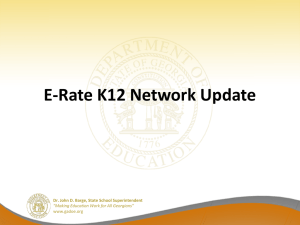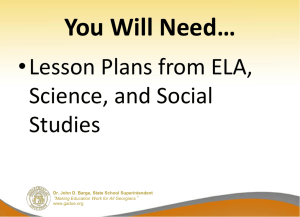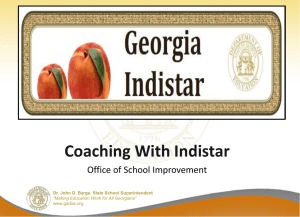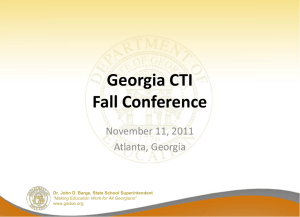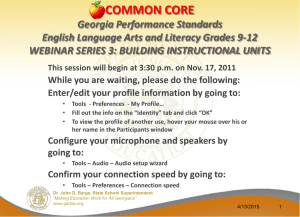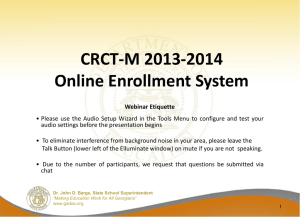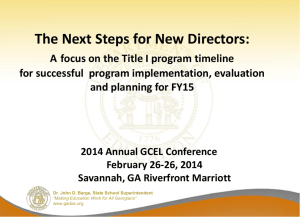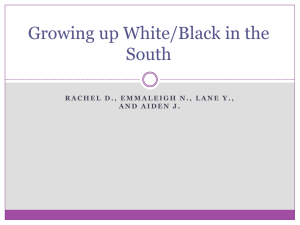Literacy Standards for Reading in Social Studies & History Grades 6
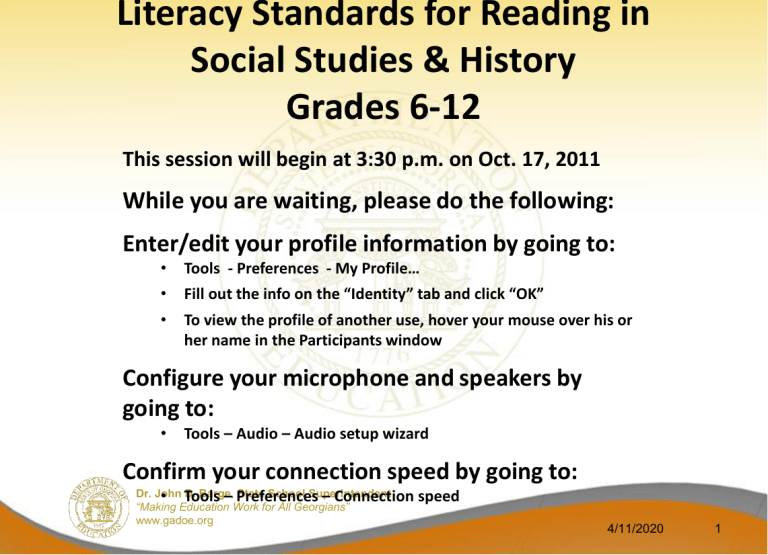
Literacy Standards for Reading in
Social Studies & History
Grades 6-12
This session will begin at 3:30 p.m. on Oct. 17, 2011
While you are waiting, please do the following:
Enter/edit your profile information by going to:
• Tools - Preferences - My Profile…
• Fill out the info on the “Identity” tab and click “OK”
• To view the profile of another use, hover your mouse over his or her name in the Participants window
Configure your microphone and speakers by going to:
• Tools – Audio – Audio setup wizard
Confirm your connection speed by going to:
• Tools – Preferences – Connection speed
“Making Education Work for All Georgians” www.gadoe.org
4/11/2020 1
Accessing the Session Recording
• Recordings are accessed by going to http://elluminate.gavirtualschools.org/doe and click on the Recordings tab.
Recordings are posted approximately 15 minutes after the session is closed
(all attendees must logout before the recordings can be created).
Dr. John D. Barge, State School Superintendent
“Making Education Work for All Georgians” www.gadoe.org
4/11/2020 2
UNDERSTANDING THE
COMMON CORE
Georgia Performance Standards
Literacy Standards for Reading in
Social Studies and History
Grades 6-12
Monday, October 17, 2011
3:30 – 4:30 pm
Dr. John D. Barge, State School Superintendent
“Making Education Work for All Georgians” www.gadoe.org
OCTOBER 2011
WELCOME!
Kim Jeffcoat
State Program Coordinator
English Language Arts and Literacy kjeffcoat@doe.k12.ga.us
CCGPS
Dr. John D. Barge, State School Superintendent
“Making Education Work for All Georgians” www.gadoe.org
Introductions
Sallie Mills
English Language Arts & Literacy Program Specialist smills@doe.k12.ga.us
Susan Jacobs
English Language Arts & Literacy Program Specialist sjacobs@doe.k12.ga.us
Andria Bunner
English Language Arts & Literacy Program Specialist abunner@doe.k12.ga.us
Angela Baker
Education Technology Specialist anbaker@doe.k12.ga.us
Julie Morrill
Literacy Program Specialist jmorrill@doe.k12.ga.us
Mary Lynn Huie
Gates Literacy Trainer mhuie@doe.k12.ga.us
Dr. John D. Barge, State School Superintendent
“Making Education Work for All Georgians” www.gadoe.org
What we’d like to share with you today…
An overview of the Literacy Standards for
Reading in Social Studies and History
Facts about implementation
A timeline for next steps
Practice implementation task
Dr. John D. Barge, State School Superintendent
“Making Education Work for All Georgians” www.gadoe.org
Standards Overview
Dr. John D. Barge, State School Superintendent
“Making Education Work for All Georgians” www.gadoe.org
Three Sets of Standards
College and Career Readiness Standards
(CCR)
Common Core Georgia Performance
Standards (CCGPS)
Literacy Standards for History/Social
Studies, Science, and Technical Subjects
Dr. John D. Barge, State School Superintendent
“Making Education Work for All Georgians” www.gadoe.org
College and Career
Readiness Standards
CCR = Umbrella Standards
32 standards serving as the benchmark for
C
ollege and
C
areer
R
eadiness
Dr. John D. Barge, State School Superintendent
“Making Education Work for All Georgians” www.gadoe.org
English Language Arts and Literacy
Common Core Georgia
Performance Standards, ELA
Reading/Literary 9
Reading/Informational 10
Reading/Foundational (K-5 only) 4
Writing 10
Speaking and Listening 6
Language 6
Dr. John D. Barge, State School Superintendent
“Making Education Work for All Georgians” www.gadoe.org
CCGPS
Literacy Standards
Grades 6-12
Reading/History, Social Studies
Reading/Science and Technical Subjects
Writing /History, Social Studies, Science, and Technical Subjects
Literacy Standards are embedded in the K-5 ELA
Standards of CCGPS
Dr. John D. Barge, State School Superintendent
“Making Education Work for All Georgians” www.gadoe.org
Literacy Standards for Reading
CCR READING STANDARD 1:
CCRR1: Read closely to determine what the text says explicitly and to make logical inferences from it; cite specific textual evidence when writing or speaking to support conclusions drawn from the text.
L6-8RH1: Cite specific textual evidence to support analysis of primary and secondary sources.
L9-10RH1: Cite specific textual evidence to support analysis of primary and secondary sources, attending to such features as the date and origin of the information.
L11-12RH1: Cite specific textual evidence to support analysis of primary and secondary sources, connecting insights gained from specific details to an understanding of the text as a whole.
Dr. John D. Barge, State School Superintendent
“Making Education Work for All Georgians” www.gadoe.org
Literacy Standards for Reading
CCR READING STANDARD 2:
CCRR2:Determine central ideas or themes of a text and analyze their development; summarize the key supporting details and ideas.
L6-8RH2: Determine the central ideas or information of a primary or secondary source; provide an accurate summary of the source distinct from prior knowledge or opinions.
L9-10RH2: Determine the central ideas or information of a primary or secondary source; provide an accurate summary of how key events or ideas develop over the course of the text.
L11-12RH2: Determine the central ideas or information of a primary or secondary source; provide an accurate summary that makes clear the relationships among the key details and ideas.
Dr. John D. Barge, State School Superintendent
“Making Education Work for All Georgians” www.gadoe.org
Literacy Standards for Reading
CCR READING STANDARD 3:
CCRR3: Analyze how and why individuals, events, and ideas develop and interact over the course of a text.
L6-8RH3: Identify key steps in a text’s description of a process related to history/social studies (e.g., how a bill becomes law, how interest rates are raised or lowered).
L9-10RH3: Analyze in detail a series of events described in a text; determine whether earlier events caused later ones or simply preceded them.
L11-12RH3: Evaluate various explanations for actions or events and determine which explanation best accords with textual evidence, acknowledging where the text leaves matters
“Making Education Work for All Georgians” www.gadoe.org
Literacy Standards for Reading
CCR READING STANDARD 4:
CCRR4: Interpret words and phrases as they are used in a text, including determining technical, connotative, and figurative meanings, and analyze how specific word choices shape meaning or tone.
L6-8RH4: Determine the meaning of words and phrases as they are used in a text, including vocabulary specific to domains related to history/social studies.
L9-10RH4: Determine the meaning of words and phrases as they are used in a text, including vocabulary describing political, social, or economic aspects of history/social science.
L11-12RH4: Determine the meaning of words and phrases as they are used in a text, including analyzing how an author uses and refines the meaning of a key term over the course of a text (e.g., how Madison defines faction in Federalist No. 10).
Dr. John D. Barge, State School Superintendent
“Making Education Work for All Georgians” www.gadoe.org
Literacy Standards for Reading
CCR READING STANDARD 5:
CCRR5: Analyze the structure of texts, including how specific sentences, paragraphs, and larger portions of the text (e.g., a section, chapter, scene, or stanza) relate to each other and the whole.
L6-8RH5: Describe how a text presents information (e.g., sequentially, comparatively, causally).
L9-10RH5: Analyze how a text uses structure to emphasize key points or advance an explanation or analysis .
L11-12RH5: Analyze in detail how a complex primary source is structured, including how key sentences, paragraphs, and larger portions of the text contribute to the whole.
Dr. John D. Barge, State School Superintendent
“Making Education Work for All Georgians” www.gadoe.org
Literacy Standards for Reading
CCR READING STANDARD 6:
CCRR6: Assess how point of view or purpose shapes the content and style of a text.
L6-8RH6: Identify aspects of a text that reveal an author’s point of view or purpose (e.g., loaded language, inclusion or avoidance of particular facts).
L9-10RH6: Compare the point of view of two or more authors for how they treat the same or similar topics, including which details they include and emphasize in their respective accounts.
L11-12RH6: Evaluate authors’ differing points of view on the same historical event or issue by assessing the authors’ claims, reasoning, and evidence.
Dr. John D. Barge, State School Superintendent
“Making Education Work for All Georgians” www.gadoe.org
Literacy Standards for Reading
CCR READING STANDARD 7:
CCRR7: Integrate and evaluate content presented in diverse formats and media, including visually and quantitatively, as well as in words.
L6-8RH7 : Integrate visual information (e.g., in charts, graphs, photographs, videos, or maps) with other information in print and digital texts.
L9-10RH7: Integrate quantitative or technical analysis (e.g., charts, research data) with qualitative analysis in print or digital text.
L11-12RH7: Integrate and evaluate multiple sources of information presented in diverse formats and media (e.g., visually, quantitatively, as well as in words) in order to address a question or solve a problem.
Dr. John D. Barge, State School Superintendent
“Making Education Work for All Georgians” www.gadoe.org
Literacy Standards for Reading
CCR READING STANDARD 8:
CCRR8: Delineate and evaluate the argument and specific claims in a text, including the validity of the reasoning as well as the relevance and sufficiency of the evidence.
L6-8RH8: Distinguish among fact, opinion, and reasoned judgment in a text.
L9-10RH8: Assess the extent to which the reasoning and evidence in a text support the author’s claims.
L11-12RH8: Evaluate an author’s premises, claims, and evidence by corroborating or challenging them with other information.
Dr. John D. Barge, State School Superintendent
“Making Education Work for All Georgians” www.gadoe.org
Literacy Standards for Reading
CCR READING STANDARD 9:
CCRR9: Analyze how two or more texts address similar themes or topics in order to build knowledge or to compare the approaches the authors take.
L6-8RH9: Analyze the relationship between a primary and secondary source on the same topic.
L9-10RH9: Compare and contrast treatments of the same topic in several primary and secondary sources.
L11-12RH9: Integrate information from diverse sources, both primary and secondary, into a coherent understanding of an idea or event, noting discrepancies among sources.
Dr. John D. Barge, State School Superintendent
“Making Education Work for All Georgians” www.gadoe.org
Literacy Standards for Reading
CCR READING STANDARD 10:
CCRR10: Read and comprehend complex literary and informational texts independently and proficiently.
L6-8RH10: By the end of grade 8, read and comprehend history/social studies texts in the grades 6-8 text complexity band independently and proficiently.
L9-10RH10: By the end of grade 10, read and comprehend history/social studies texts in the grades 9-10 text complexity band independently and proficiently.
L11-12RH10: By the end of grade 12, read and comprehend history/social studies texts in the grades 11–12 text complexity band independently and proficiently.
Dr. John D. Barge, State School Superintendent
“Making Education Work for All Georgians” www.gadoe.org
Facts About CCGPS Implementation
Dr. John D. Barge, State School Superintendent
“Making Education Work for All Georgians” www.gadoe.org
CCGPS Implementation Timeline
ACTION
TEACH 100% GPS
TEACH 100% CCGPS
With GPS transition guidance
TEACH 100% CCGPS
With GPS transition guidance
TEACH 100% CCGPS
YEAR
2011-2012
2012-2013
2013-2014
2014-2015
Dr. John D. Barge, State School Superintendent
“Making Education Work for All Georgians” www.gadoe.org
Facts
The content of existing unit frameworks for social studies/history will not change.
All references to “Reading Across the Curriculum” standards from GPS will be replaced with these standards.
CCGPS will not dictate how teachers should teach but allow schools and teachers to decide how best to help students reach the standards.
The Literacy Standards for Reading in social studies and history mandate standards for reading in accessing text within the course.
Dr. John D. Barge, State School Superintendent
“Making Education Work for All Georgians” www.gadoe.org
Facts, continued…
Clarity and staircase design allow for ease in constructing pre-assessments using previous grade CCGPS.
Best practices will not change:
Relevant Multimodal Student-focused
Authentic Collaborative Purposeful
Strategic steps for professional learning and implementation are moving forward according to schedule.
By joining us for this webinar, you are on target in your preparation in this preliminary phase.
Dr. John D. Barge, State School Superintendent
“Making Education Work for All Georgians” www.gadoe.org
Resources
Dr. John D. Barge, State School Superintendent
“Making Education Work for All Georgians” www.gadoe.org
“If you don't like the way the world is, you change it.
You have an obligation to change it. You just do it one step at a time .”
~Marion Wright Edelman
All change brings with it some anxiousness and uncertainty
We understand (and appreciate!) your eagerness to begin this process
Rest assured that resources are being provided on a strategic schedule that will allow our focus to remain on GPS for 2011
Dr. John D. Barge, State School Superintendent
“Making Education Work for All Georgians” www.gadoe.org
Learning Design Collaborative
(LDC)
• A grant funded by the Bill and Melinda Gates Foundation
• Big idea is the infusion of literacy strategies in reading and writing into content coursework and instruction via an instructional ladder
• Current work is all subjects grades 6-12
• One vehicle of the project is “plug and play” templates
• Stay tuned for more information in the coming months regarding the progress of the project
Dr. John D. Barge, State School Superintendent
“Making Education Work for All Georgians” www.gadoe.org
Dr. John D. Barge, State School Superintendent
“Making Education Work for All Georgians” www.gadoe.org
Next Steps
Dr. John D. Barge, State School Superintendent
“Making Education Work for All Georgians” www.gadoe.org
What Should I Be Doing Now?
Establish a deep familiarity with the CCGPS
Study the K-12 Educator Resource document
Collaborate and discuss with your peers
Study the GaDoe site and resources
Implement the practice tasks in this webinar
Attend the next webinar: Literacy Standards for Writing/ November 9, 2011, @3:30 p.m.
Attend the GPB live-streaming professional learning sessions
Sign up for the ELA listserv and read our newsletter and newsflashes
Relax!
Dr. John D. Barge, State School Superintendent
“Making Education Work for All Georgians” www.gadoe.org
Practice Implementation Tasks
Dr. John D. Barge, State School Superintendent
“Making Education Work for All Georgians” www.gadoe.org
What you see below is an actual task within the balanced assessment section of the GaDOE frameworks for
6 th grade Social Studies, Unit 15, page 2
Students will list three job or career choices. The student will locate the salaries of each job. For each career choice, the student will list the amount of income he/she could possibly earn. The student will then list steps to accomplish the goal of procuring that particular job.
Use the Occupational Handbook, http://www.bls.gov/oco/home.htm
Common Core Literacy Standard for Reading
L6-8RH3: Identify key steps in a text’s description of a process related to history/social studies (e.g., how a bill becomes law, how interest rates are raised or lowered).
Dr. John D. Barge, State School Superintendent
“Making Education Work for All Georgians” www.gadoe.org
What you see below is an actual task within the balanced assessment section of the GaDOE frameworks for
7 th grade Social Studies, Unit 1, page 3
Students will use media (print or internet) to find three pictures that illustrate economy. They will then write which elements of economy are depicted and which stage of production the goods in the picture are in. They will then create a flow chart tracing one of the goods from production to distribution.
Common Core Literacy Standard for Reading
L6-8RH7: Integrate visual information (e.g., in charts, graphs, photographs, videos, or maps) with other information in print and digital texts.
Dr. John D. Barge, State School Superintendent
“Making Education Work for All Georgians” www.gadoe.org
What you see below is an actual task within the balanced assessment section of the GaDOE frameworks for
8 th Grade Social Studies, Unit 4, Page 4.
Working with a partner, students should read and examine the Declaration of
Independence. They should make a list of complaints found in the Declaration against the king. Then the partners should decide which three complaints they feel is the most damaging to the colonists’ relationship to the king. They should then rewrite these three complaints in their own words. They need to explain why this action by the king was so grievous to the colonists.
Common Core Literacy Standard for Reading
L6-8RH2: Determine the central ideas or information of a primary or secondary source; provide an accurate summary of the source distinct from prior knowledge or opinions.
Dr. John D. Barge, State School Superintendent
“Making Education Work for All Georgians” www.gadoe.org
What you see below is an actual task within the balanced assessment section of the GaDOE frameworks for
9 th Grade Am. Govt. & Civics, Unit 4, Page 4 .
Students will research the background of the articles of impeachment in both President Andrew Johnson and
President Clinton’s cases. Students will then compare and contrast the articles against both presidents and the historical circumstances in a short two page essay.
Common Core Literacy Standard for Reading
L9-10RH9: Compare and contrast treatments of the same topic in several primary and secondary sources.
Dr. John D. Barge, State School Superintendent
“Making Education Work for All Georgians” www.gadoe.org
What you see below is an actual task within the balanced assessment section of the GaDOE frameworks for
10 th Grade World History, Unit 4, Page 5.
Students will read selections from the Justinian Code. They should make comparisons to modern United States law codes with similarities and differences in the nature of laws. Students should make assessments of the extent of the influence of Roman law on modern legal concepts.
Common Core Literacy Standard for Reading
L9-10RH9: Compare and contrast treatments of the same topic in several primary and secondary sources.
Dr. John D. Barge, State School Superintendent
“Making Education Work for All Georgians” www.gadoe.org
What you see below is an actual task within the balanced assessment section of the GaDOE frameworks for
11 th Grade American History, Unit 5, Page 3.
Students will examine primary source documents from the
Reconstruction era. www.enotes.com/reconstruction-era-primary-sources www.thenagain.info/WebChron/USA/ReconstructionEra.html
These may include photographs, letters, and other visuals. Students, in small groups, will break down the historical background and events addressed in the document.
Common Core Literacy Standard for Reading
L11-12RH1: Cite specific textual evidence to support analysis of primary and secondary sources, connecting insights gained from specific details to an understanding of the text as a whole.
Dr. John D. Barge, State School Superintendent
“Making Education Work for All Georgians” www.gadoe.org
What you see below is an actual task within the balanced assessment section of the GaDOE frameworks for
12 th Grade Economics, Unit 4, Page 3.
Government Intervention Film Clips: Following appropriate copyright policies, students view a clip(s) of a film or television show that illustrates various roles of the government in a market economy. During the clips, students will cite examples of public goods and services, redistribution of income, protection of private property rights, resolution of market failures and of government regulation / deregulation. Some video clip examples include: Erin Brockovitch,
The Simpsons: Two Cars in Every Garage, Three Eyes on Every Fish, etc. See graphic organizer below.
Common Core Literacy Standard for Reading
L11-12RH7: Integrate and evaluate multiple sources of information presented in diverse formats and media (e.g., visually, quantitatively, as well as in words) in order to address a question or solve a problem.
Dr. John D. Barge, State School Superintendent
“Making Education Work for All Georgians” www.gadoe.org
Activity
Dr. John D. Barge, State School Superintendent
“Making Education Work for All Georgians” www.gadoe.org
Answer Key: Grades 6, 7, 8
Grade 6 Task One: L6-8RH2 (RH7)
Grade 6 Task Two: L6-8RH7
Grade 7 Task One: L6-8RH4 (RH2)
Grade 7 Task Two: L6-8RH3
Grade 8 Task One: L6-8RH1 (RH2)
Grade 8 Task Two: L6-8RH2 (RH6)
Dr. John D. Barge, State School Superintendent
“Making Education Work for All Georgians” www.gadoe.org
Connections
6-1: Research cultural characteristics of European countries (L6-8RH2: determine central ideas of secondary source documents and provide summary; RH7: visuals/graphics)
6-2: Study virtual exhibit of artifacts and primary source documents from conquest of
Aztecs (L6-8RH7: Integrate visual information with other information in print and digital texts)
7-1: Use CIA Fact book to determine government structure using vocabulary words found in the standard (L6-8RH4: Determine meaning of words specific to domain; L6-8RH2 provide accurate summary of central ideas from a primary or secondary source)
7-2: Research how climatic conditions impact population, trade, agriculture, and industry
(L6-8RH3: Identify key steps in a process related to social studies)
8-1: Students analyze the Charter of 1732, comparing to “Three Main Reasons for
Founding of Georgia in text to determine whether the Charter’s objectives were met
(L6-8RH9: Analyze the relationship between a primary and secondary source on the same topic).
8-2: Compare the Missouri Compromise, Compromise of 1850, and Kansas-Nebraska Act to understand the debate over slavery’s spread to the West (L6-8H6: Identify aspects of a text that reveal an author’s point of view or purpose [e.g., loaded language, inclusion or avoidance of particular facts]).
Dr. John D. Barge, State School Superintendent
“Making Education Work for All Georgians” www.gadoe.org
Answer Key: Grades 9, 10, 11, 12
Grade 9 Task One: L9-10RH2
Grade 9 Task Two: L9-10RH6 (RH9)
Grade 10 Task One: L9-10RH7 (RH6)
Grade 10 Task Two: L9-10RH3
Grade 11 Task One: L11-12RH2
Grade 11 Task Two: L11-12RH7
Grade 12 Task One: L11-12RH3
Grade 12 Task Two: L11-12RH2 (RH7)
Dr. John D. Barge, State School Superintendent
“Making Education Work for All Georgians” www.gadoe.org
Connections
9-1: Identify and analyze protections within each amendment (RH2: determine central idea of primary source document)
9-2: Analyze the Declaration of Independence via Social Contract Theory
(L9-10RH6: Compare the point of view of two or more authors for how they treat the same or similar topics).
10-1: Examine primary sources (mosaics, icons, diaries, photos) of Hagia
Sophia to determine elements of Byzantine culture (L9-10RH7:
Integrate quantitative or technical analysis [e.g., charts, research data] with qualitative analysis in print or digital text. RH6: compare points of view).
10-2: Research the question “Why did westerners travel to China and
Japan (Opium War, Taiping Rebellion, Commodore Perry) (L9-10RH3:
Analyze in detail a series of events described in a text; determine whether earlier events caused later ones or simply preceded them).
Dr. John D. Barge, State School Superintendent
“Making Education Work for All Georgians” www.gadoe.org
Connections
11-1: Examine primary source documents including photographs from
Reconstruction to understand historical context (L11-12RH2: Determine the central ideas of a primary source; provide a summary that makes clear the relationships).
11-2: Examine historical political cartoons to analyze the Progressive movement
(L11-12RH7: Integrate and evaluate multiple sources of information in diverse formats [e.g., visually]) in order to address a question.
12-1: Review form and function of neurons through fictional case studies of patients
(L11-12RH3: Evaluate various explanations for actions or events and determine which explanation best accords with textual evidence, acknowledging where the text leaves matters uncertain).
12-2: Introduction to theories of social behavior (Harlow, Piaget, Benedict) through virtual exploration (L11-12RH2Determine the central ideas or information of a primary or secondary source; provide an accurate summary that makes clear the relationships among the key details and ideas).
Dr. John D. Barge, State School Superintendent
“Making Education Work for All Georgians” www.gadoe.org
Our Next 6-12 Webinar:
November 9, 2011, @ 3:30 p.m.
Focus: Literacy Standards for Writing
We would welcome input from the field on your experiences with constructing integrated tasks and lessons based on the examples we’ve seen here today or your experiences teaching these tasks. Send lessons, comments, and photos to ELAinput@doe.k12.ga.us
.
Dr. John D. Barge, State School Superintendent
“Making Education Work for All Georgians” www.gadoe.org
Am I going to be prepared to integrate these new standards next school year? (2012-13)
Dr. John D. Barge, State School Superintendent
“Making Education Work for All Georgians” www.gadoe.org
